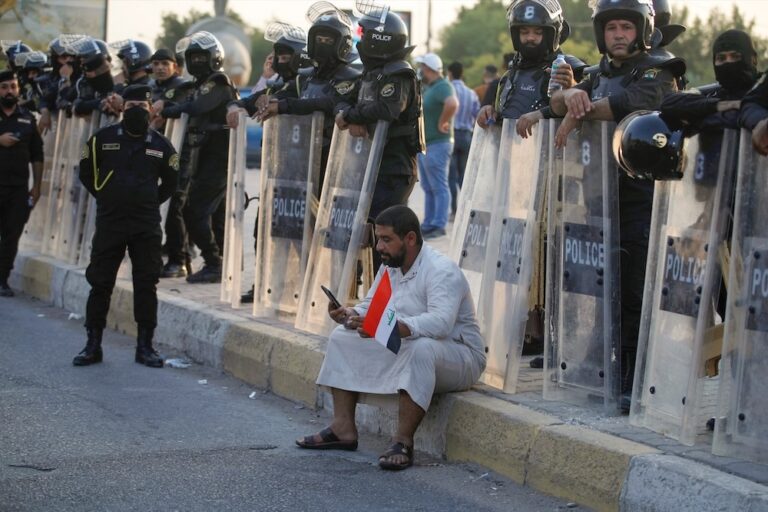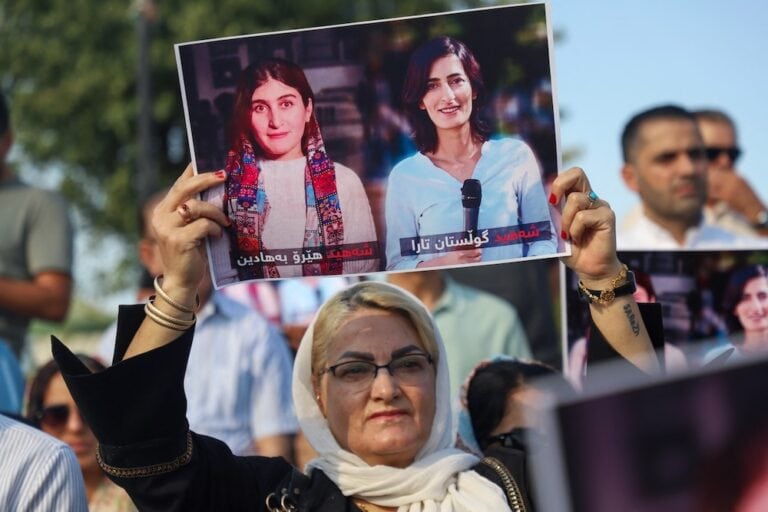Rahman Gharib, coordinator for the local press freedom group Metro Center to Defend Journalists, was beaten on the head and leg, and arrested by security forces after he took some photographs during protests in Sulaimaniya.
(Human Rights Watch/IFEX) – Beirut, March 1, 2012 – Uniformed security forces clamped down on demonstrations marking February 2012 anniversaries of the start of weekly protests in Iraq, Human Rights Watch said today. Security forces blocked access to protest sites in Baghdad; beat and arrested peaceful demonstrators in Sulaimaniya, Kurdistan; and briefly detained, beat, or confiscated equipment from media workers and prevented others from covering the protests.
Human Rights Watch interviewed more than 15 demonstrators, bystanders, and journalists who were at the demonstrations on the February 17 and 25 anniversaries in Kurdistan and Baghdad, respectively. Activists said that in the build-up to the demonstrations, security forces threatened them with arrest and unidentified people threatened them with violence if they attended.
“Security forces are using repressive means to keep peaceful protestors at bay,” said Sarah Leah Whitson, Middle East director at Human Rights Watch. “While the level of violence may be lower than it was a year ago, the effect is the same – preventing Iraqis from engaging in peaceful dissent.”
Beatings and Detentions in Sulaimaniya
In the year since protests began in Iraqi Kurdistan, security forces there have killed at least 10 protesters and bystanders and injured more than 250.
On February 17, 150 to 200 protesters walked past hundreds of security forces to assemble peacefully in Sulaimaniya’s Sara Square at about 11:30 a.m.
“We went to honor the martyred protesters who died there last February,” said one protester who spoke to Human Rights Watch.
Within 10 minutes, hundreds more security forces surrounded and filled the square, and dozens of men in civilian clothing approached the protesters and began to punch, kick, and strike them with wooden batons, protesters and journalists told Human Rights Watch. The men forced many of the protesters to one side of the square, next to a former police station that was used as a temporary security headquarters for the protests. There, security forces detained protesters inside the building.
Hilal Ibrahim, a lawyer, told Human Rights Watch that he was attacked by men in civilian clothing while hailing a taxi after visiting a market adjacent to Sara Square. He said he was punched in the back and was asked, “Why did you come to demonstrate?” He said that while security forces looked on, several men in civilian clothes with wooden batons pushed him into a nearby garage until one of the men ordered the others to stop. The man told Ibrahim, “Go home, or we will kill you.”
Security forces detained journalists and photographers covering the protests. They confiscated the camera of Rahman Gharib, coordinator for the local press freedom group Metro Center to Defend Journalists, and beat him on the head and leg after he took some photographs, Gharib and witnesses told Human Rights Watch. The Metro Center has documented numerous abuses against Kurdish journalists, including more than 200 cases of attacks and harassment during the protests in Sulaimaniya between February and May, 2011.
“One of the colleagues tried to intervene [when they were beating me] and he told security forces that I was working for Metro Center. To that, one of them screamed ‘Fuck you and fuck Metro Center’ and arrested my colleague as well,” said Gharib, who wore an orange vest to identify himself as an observer. “I have bruises on my left leg and right hand. I have a few swollen spots on my head. They still have my cellphone.”
Witnesses also said security forces struck in the face a middle-aged man who attempted to convince them to release Gharib, causing a bleeding cut above the man’s left eye. As security forces took Gharib through the crowd, they grabbed and kicked Sebastian Meyer, an American photographer from the Metrography photography agency, who was documenting the arrest. Meyer told Human Rights Watch that security forces then took his camera and phone and arrested him, along with an Iraqi photographer, Pazhar Mohammed. Local journalists said that security forces also detained other media workers, including crews from KNN television, NRT television, and journalists from other local media organizations.
Witnesses told Human Rights Watch that inside their makeshift headquarters on the square, security forces interrogated 25 to 30 protesters and journalists, some in groups and some alone. Shortly before 1 p.m., security forces transported them by bus to the main peshmerga prison in Sulaimaniya, known as Fermanday, on the western outskirts of the city.
At Fermanday prison, security forces separated Meyer from the other detainees, along with an American teacher who had been at the square and had been mistaken for a foreign journalist. Meyer told Human Rights Watch that, at about 2 p.m., they were driven first to the Politburo for the Patriotic Union of Kurdistan, a governing political party, and then to the Sulaimaniya residency office, where authorities confiscated Meyer’s Kurdistan residency card and told him that he was being deported. Security officials released Meyer and the teacher at 4 p.m. They returned Meyer’s camera and phone but not his residency card.
One protester who was also detained told Human Rights Watch: “I was punched in the head and back when they arrested me in the square, like all the other protesters, but I was not physically mistreated in the prison. Officers just kept asking us questions for 90 minutes at a time. They asked who had told me to demonstrate . . . They ordered all the protesters to sign legal pledges never to attend any protests again, explaining that we would not be released until we signed. Some signed, but some of us refused. After a long time, they said we could just sign pledges never to attend protests that are not permitted by the government, and so we did this. We were not released until 9 at night.”
(. . .)


